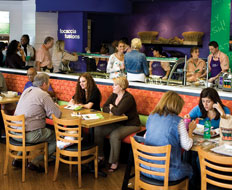In the quick-service world, there is a clear expectation for customers who join the drive-thru or in-store queue: to get quality food fast. While the tough economy forced many restaurants to streamline business, experts warn that quick serves must remain just that—quick.
“Speed of service is in direct correlation to your overall retail sales,” says John Scardapane, founder and CEO of Philadelphia-based Saladworks.
Scardapane says cutting down on service staff is a traditional method for quick serves looking to streamline business, but it can be the kiss of death for a quick serve because it slows service.
“You can cut down and streamline your kitchen and hourly staff in the back of the house, but you can never cut down your sales force or the amount of staff you have in the front of the house to affect the speed of service,” he says. “One customer that’s unhappy and doesn’t come back costs you a lot more than the hourly rates you’re trying to save by cutting back one employee.”
Maintaining staff levels at the front of the house is critical, says John Pepper, CEO of Boston-based Boloco, because although many customers have decreased disposable incomes, they increased their expectations for good service. “They value the experience even more now and have traded down from full service in many instances,” Pepper says.
The consumer demand for more affordable food creates both an opportunity and a challenge for quick serves. New customers create profit potential, but there may be only one chance to turn a one-time visitor into a regular customer.
“While I might wait an extra two minutes this time, next time I’m in a hurry I might go somewhere else,” says Isidore Kharasch, president of Hospitality Works Inc., an operational foodservice consulting and training firm. “The lifeblood of any restaurant is the return customer.”
That’s not to say that customers are rigid. Many customers don’t mind waiting for good food if they feel that a long line is steadily moving. “If the line is moving because you have [good] speed of service, customers don’t mind waiting 10 minutes,” Scardapane says. “If you have only one or two people in front of you and it takes 10 minutes, you’ll be annoyed by the time you get service. So people appreciate speed of service, even if they have to queue up in line.”
One strategy for increasing speed of service is to evaluate the daily operational procedures and to measure the number of steps it takes to deliver food to the customers.
“Revisit all of your current training procedures, and reassess your menu and physical plan for ergonomic opportunities,” Pepper says. “We go down to the individual morsels of rice that we use in our burritos and bowls, and analyze the number of footsteps or arm stretches it takes to get food to our guests.”
Often, the bottlenecks in service are due to the restaurant’s overall design and setup. “Many operations that I have consulted with made all of their mistakes in the design phase,” Kharasch says. “They did not think through every step an employee has to make to get the food out and they did not think about where a guest stands when waiting to order food, or how many registers they may need if the sales are above expectations.”
Kharasch says bottlenecks frequently occur in the crossover between the drive-thru and in-store service crews, slowing down the entire operation.
“When I work with clients in the design phase, especially of a drive-thru component, we look at making that a station unto itself,” Kharasch says. “This means the person working the drive thru has easy access to beverages, condiment packets, and direct delivery of food from the kitchen line. This keeps the line moving for cars, cuts down on labor cost, and makes the operation more efficient.”
The drive thru, on average, represents more than 65 percent of a restaurant’s revenue, says Frank Amoruso, president and chief operating officer of HyperActive Technologies Inc., a provider of restaurant technology solutions, including predictive kitchen-management systems. “In no other area does poor speed of service have a more negative impact on the restaurant,” he says. “Drive-thru experiences of acceptable speed, correct orders, quality food, and pleasant customer service nearly insure return customers.”
Scardapane and Pepper say that, in order to protect the speed of service at their restaurants, quick serves should look away from cutting back on employees and crew hours and look instead at ways to save money with their vendors.
“What the recession forced us to do was dig harder to find cost-saving opportunities,” Pepper says. “On cost of food, we asked more from our vendors, checked more invoices, and got more disciplined with asking for credits when subpar ingredients were delivered to our restaurants, versus just throwing them away.”
Scardapane looks for similar savings with his vendors and says that in this economic environment, everything is up for negotiation.
“I would encourage other restaurants to go back and talk to all of their purveyors, even their landlords,” he says. “We used the economy as a perfect reason to go back to all of our manufactures and renegotiate our contracts. So we never sacrifice food quality or service. We went back to the manufacturers and said, ‘We’re happy to do business with you, but you’re going to have to reduce your costs.’ And 90 percent of them did. We were able to go back and renegotiate our existing specs for food and reduce the costs that way.”
With the quick-service industry becoming increasingly competitive, Amoruso says something like maintaining speed of service can make a world of difference to an operator.
“It is clear that competition for the consumer is intense,” he says. “Meal deals only go so far, especially when everybody is offering one. It is the customer experience that dictates the winner in the competition. Use the tools available to you and don’t shy away from change.”











